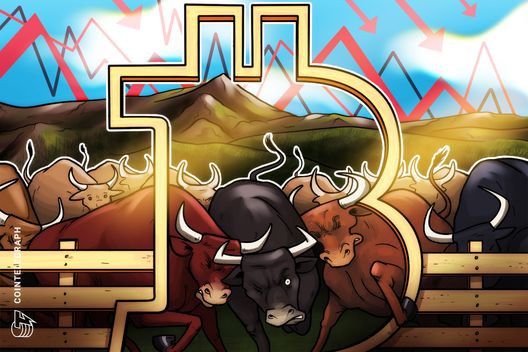
Der Altseason-Index ist diese Woche auf einen Bestwert von 76 Punkten geklettert, was nahelegt, dass die Hochphase der Altcoins bereits läuft.

Finanzmittel Info + Krypto + Geld + Gold
Krypto minen, NFT minten, Gold schürfen und Geld drucken

Der Altseason-Index ist diese Woche auf einen Bestwert von 76 Punkten geklettert, was nahelegt, dass die Hochphase der Altcoins bereits läuft.

Experten sind sich uneinig, ob der Bullenmarkt schon 2025 endet oder bis 2027 anhält. Institutionelle Nachfrage wächst, doch Zinsen, Inflation und die Aktienmärkte bleiben mögliche Risiken.
Polygon’s token POL is up 1.6% as bulls try to break higher following a recent drop amid the proof-of-stake network’s node software bug that introduced a 10-15 minute delay in transaction finality.
But with the platform implementing an important fix, could the retest of the $0.275 area allow bulls to once again dominate?
The POL token’s jump to above $0.27 means the Polygon price is hovering near a key level above which buyers have previously rallied to $0.71.
On September 10, 2025, Polygon’s network announced its team had successfully implemented a fix to a bug that saw a node software malfunction cause a transaction finality delay.
While this briefly disrupted the decentralized applications (dApps) and remote procedure call (RPC) services, developers swiftly deployed a hard fork and software updates that have resolved the issue.
Specifically, the disruption stemmed from a bug in the Bor and Erigon node configurations, which impeded validator synchronization and milestone processing.
“We identified the cause of the finality issue and have rolled out v2.2.11-beta2 for Bor and v0.3.1 for Heimdall, the latter a hardfork to be implemented at 3PM UTC,” Polygon wrote.
Node restarts resolved issues for most validators and RPC providers, with the network achieving full consensus restoration shortly thereafter.
An update later provided more details:
“The hard fork has been successfully completed, and milestones are now processing normally along with state sync. Checkpoints are going through and consensus finalization has been fully restored on Polygon PoS.”
Polygon co-founder Sandeep Nailwal commented on the incident, emphasizing that this setback is part of the “growing pains” for the network.
The price of POL reacted negatively to the initial announcement, but looks set for a steady rebound alongside other top coins. On the bug fix and upgrade issues, Nailwal noted:
“The team is still monitoring the network closely and is investigating how this scenario occurred in the first place. I’m extremely grateful to our team of engineers for quickly identifying and resolving this issue, and for the patience and understanding of our community.”
Sentiment across crypto presents a bullish outlook for tokens, but as seen in recent weeks, POL’s structure remains largely bearish.
After a breakout to the upper limit of an ascending channel on the daily chart, the token has dipped to leave buyers battling pressure below the $0.30 area.

Technical indicators such as the RSI at 55 suggests room for bulls to grow. However, the MACD presents a mixed signal with a hint of a bearish crossover.
If upside momentum holds, POL price could target $0.54. Conversely, a dip below the $0.25 level could escalate the downturn to $0.20 and lower.
The post POL price outlook as Polygon implements key bug fix appeared first on CoinJournal.

Ein bekannter Krypto-Analyst erwartet, dass Bitcoin bis 2035 auf 10 Millionen US-Dollar steigt. Joe Burnett begründet seine Prognose mit der festen Begrenzung von Bitcoin und möglichen Kapitalflüssen aus traditionellen Anlagen.
Linea’s much-hyped token launch has turned chaotic, with the LINEA price collapsing more than 90% within hours of its debut despite high-profile listings on Binance, Bybit, and OKX.
The token, part of ConsenSys’ zkEVM Layer 2 network, surged briefly on September 9 from $0.030 to as high as $0.046 after its exchange listings.
However, heavy profit-taking and a chaotic token airdrop process triggered a wave of selling that erased most of the early gains.
Linea’s token went live on September 9 through what the project described as one of Ethereum’s largest community airdrops in years.
Roughly 9.36 billion tokens were distributed across about 749,000 eligible wallets, part of a wider allocation that placed 22% of the total supply in circulation at launch.
In an unusual approach, the distribution excluded venture capital firms, team members, and advisors, positioning itself as a community-first experiment.
The launch, however, did not unfold smoothly. Network congestion created long waits and higher fees for users claiming tokens.
To complicate matters further, Linea’s mainnet sequencer briefly halted block production just before the token generation event, stoking frustration.
Although the issue was resolved within an hour, the delay has already fueled perceptions of a bungled rollout at a critical moment.
The project enjoyed immediate exposure on Binance, Bybit, OKX, Bitget, and other top platforms, helping the LINEA token price rally from its launch price of $0.030 to an all-time high of $0.046.
However, the gains evaporated within hours, and by the evening of September 10, LINEA had collapsed to $0.023, wiping out nearly half its value.
Some data points show the drop was even more severe on certain exchanges.
On OKX, for example, the auction-based launch initially steadied price discovery around $0.03, only for a flood of sell orders to overwhelm liquidity and drive the token as low as $0.024, a massive fall from a reported peak near $0.32.
Beyond profit-taking, the airdrop process itself drew sharp criticism.
Community members reported delays in claiming their allocations, while Binance users appeared to receive tokens instantly.
Blockchain analysts later confirmed that the contract funding the community airdrop was deployed roughly 50 minutes late, giving exchange-linked recipients an advantage.
The $LINEA tokens were sent to the claim contract 50 minutes late for airdrop users, while Binance users were already claiming and dumping instantly.
Tx: https://t.co/N52Vpyxk5M@DeclanFox14 @Alain_Ncls
Why was the community airdrop delayed 50 minutes without any announcement? pic.twitter.com/nXmQHqtDgA
— Zack (@0xZackHQ) September 10, 2025
In addition, critics labelled the event as favouring centralised players in what was meant to be a decentralised distribution.
Today $Linea dropped an airdrop for the community…
But at TGE — no one could even claim their tokens.Meanwhile, Binance users got theirs instantly.
This is not just a glitch — it’s how projects farm hype, extract attention, and then sideline the real community.
🚨 Time to… pic.twitter.com/Do04C3yF32
— rowdy.eth🇮🇳 (@rcboyxeth) September 10, 2025
The perception of unfairness coincided with immediate selling pressure from those who secured allocations early.
With more than 15 billion tokens unlocked on day one, Linea’s circulating supply represented over 21% of its total issuance, a ratio considered unusually high for a new token.
This only intensified fears of inflation and short-term dumping.
Linea has attempted to distinguish itself through what it calls deflationary tokenomics.
A dual-burn model sends 20% of net Layer 2 fees to be destroyed as ETH, while the remaining 80% is used to buy LINEA from the open market and burn it.
The system is designed to create consistent buy pressure, setting it apart from rivals such as Arbitrum and Optimism.
However, Linea lacks a decentralised governance structure.
While 85% of the total supply has been earmarked for ecosystem growth, decision-making remains concentrated, leaving unanswered questions about transparency and long-term control.
Despite the price collapse, Linea’s ecosystem metrics remain robust.
Its total value locked has surged to $2.984 billion according to data from DeFiLlama, with Aave alone holding more than $776 million on the network.
Daily active addresses average nearly 50,000, while decentralised exchange volumes recently surpassed $215 million in a single day.
But whether those fundamentals can support a price rebound remains unclear.
Eyes are on the $0.024 support level, with speculations that the selloff may have flushed out short-term holders, paving the way for a more stable market, although the scheduled token distributions, including the upcoming Linea Ignition program, could trigger another wave of declines.
The post LINEA price analysis as muddled airdrop causes plunge despite high-profile listings appeared first on CoinJournal.